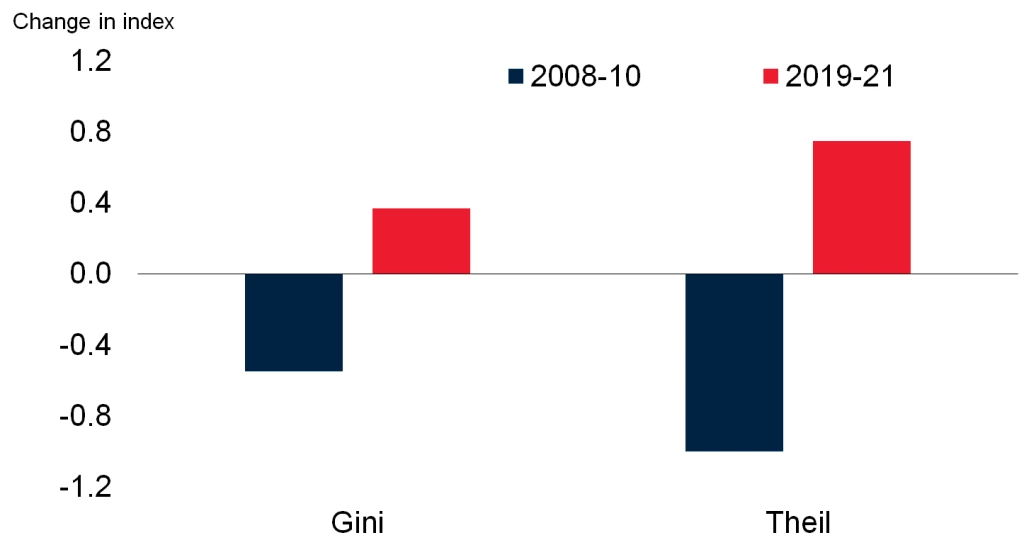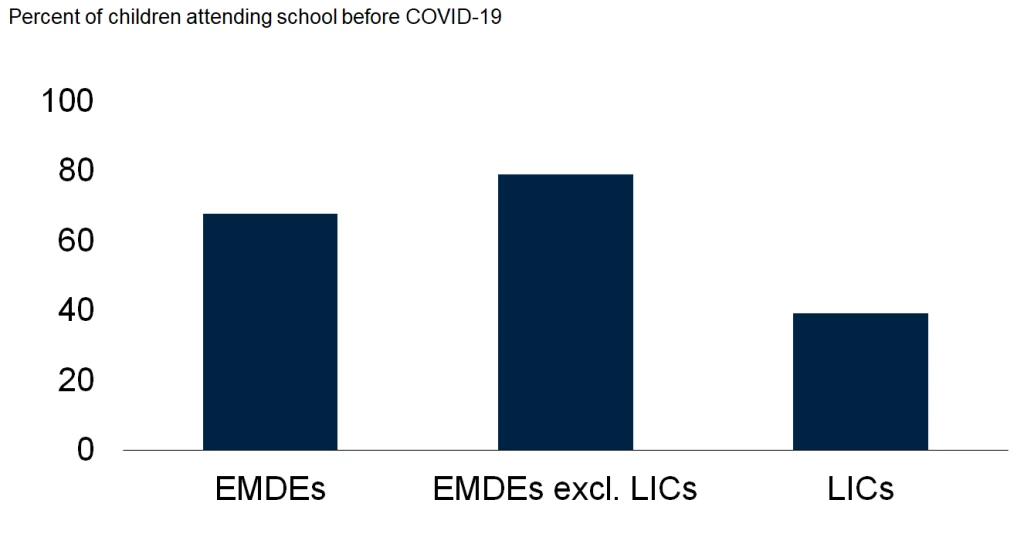 厄瓜多尔疫情期间的普通民众。
厄瓜多尔疫情期间的普通民众。
The ongoing COVID-19 pandemic has exacerbated global income inequality, partly reversing the decline of the previous two decades. Weak recoveries in emerging market and developing economies (EMDEs) are expected to raise between-country inequality. Within-country income inequality is also estimated to have increased somewhat in EMDEs because of severe job and income losses among lower-income population groups. Rising inflation, as well as pandemic-related disruptions in education could further increase within-country inequality in the longer run. Reversing the increase in global income inequality requires measures to reduce between-country and within-country inequality, underpinned by support from the global community.
Read more on the topic in the January 2022 Global Economic Prospects.
Considerable increase in between-country inequality
The COVID-19 pandemic jeopardizes the progress made in reducing global income inequality achieved in the previous two decades. In contrast to the global financial crisis of 2008-10, the deep recession triggered by the pandemic and the lagging economic recovery in EMDEs compared with advanced economies have raised between-country income inequality. By some measures—between-country Gini and Theil indices based on real per capita GDP—between-country inequality reversed back to levels of the early 2010s.
Change in global between-country income inequality
Sources: World Bank.
Note: The figure shows annualized changes in the between-country Gini and Theil indices in 2008-10 and 2019-21. The calculations are based on a strongly balanced panel of 176 countries. The Gini index is on 0-100 scale. The Theil generalized entropy GE (1) index and the Gini index are computed using GDP per capita, purchasing power parity-adjusted (constant 2017 international dollars), based on the World Bank’s World Development Indicators and growth estimates.
Moderate increase in within-country income inequality in EMDEs
The pandemic is estimated to have increased within-country income inequality in EMDEs, although the magnitude of the increase has been small, on average. Simulations for a sample of 34 EMDEs with sufficient data, suggest that income inequality, as measured by the Gini index, has increased in 2020 by 0.3 points, reversing the continued decline in income inequality observed in EMDEs since the 2000s. The magnitude of the increase, however, is relatively small—comparable to an annual average decline in within-country inequality in the preceding two decades in this sample. The increase in within-country inequality reflected severe job and income losses among low-skilled workers, low-income households, informal workers, and women.
Change in within-country income inequality in EMDEs, 2019-20

Sources: Narayan et al. (2022); World Bank.
Note: EMDEs = emerging market and developing economies; LICs = low-income countries. The figure shows the difference between the estimated average change in the Gini index in the COVID-19 scenario and the no-pandemic counterfactual scenario. The simulations estimate the changes in the income distribution of households in 2020 against a counterfactual 2020 income distribution that assumes the last pre-pandemic sectoral output growth forecast for 2020. The sample includes 34 countries. The simulations are based on country-specific sectoral growth projections and the Harmonized High-Frequency Phone Surveys data as of July 2021.
Risks of income inequality increases in the longer run
The increase in within-country inequality caused by the pandemic may become entrenched as pandemic-induced disruptions to education and the disproportionate adverse effects on low-income households may worsen intergenerational mobility. High inflation and surging public debt levels may hamper countries’ ability to support vulnerable groups and facilitate recovery and sustainable growth.
Children engaged in education during school closures in EMDEs, 2020
Sources: World Bank.
Note: EMDEs = emerging market and developing economies; LICs = low-income countries. Calculations based on the Harmonized High-Frequency Phone Surveys data from the COVID-19 Household Monitoring Dashboard for wave 1 in 2020. Response to survey question about children engaged in any education activities since school closures (percent of household with school age children who attended school before the pandemic), by income group (simple averages). Sample consists of 49 EMDEs, including 14 LICs.
Comprehensive policy effort to lower income inequality.
A comprehensive strategy is needed to steer the global economy onto a more inclusive development path. Such a strategy needs to include measures to reduce both between-country and within-country inequality through national reforms and with support from the global community. This involves a rapid global rollout of vaccination and productivity-enhancing reforms in EMDEs to lower between-country inequality; fiscal support targeted at vulnerable population groups and measures to broaden access to education, health care, digital services and infrastructure; and assistance from the global community to resolve debt overhangs and to ensure an open and rules-based global trade and investment climate that nurtures faster productivity growth in EMDEs.
References
Narayan, A., A. Cojocaru, S. Agrawal, T. Bundervoet, M. Davalos, N. Garcia, C. Lakner, et al. 2022. “COVID-19 and Economic Inequality: Short-Term Impacts with Long-Term Consequences.” Policy Research Working Paper 9902, World Bank, Washington, DC.




Join the Conversation